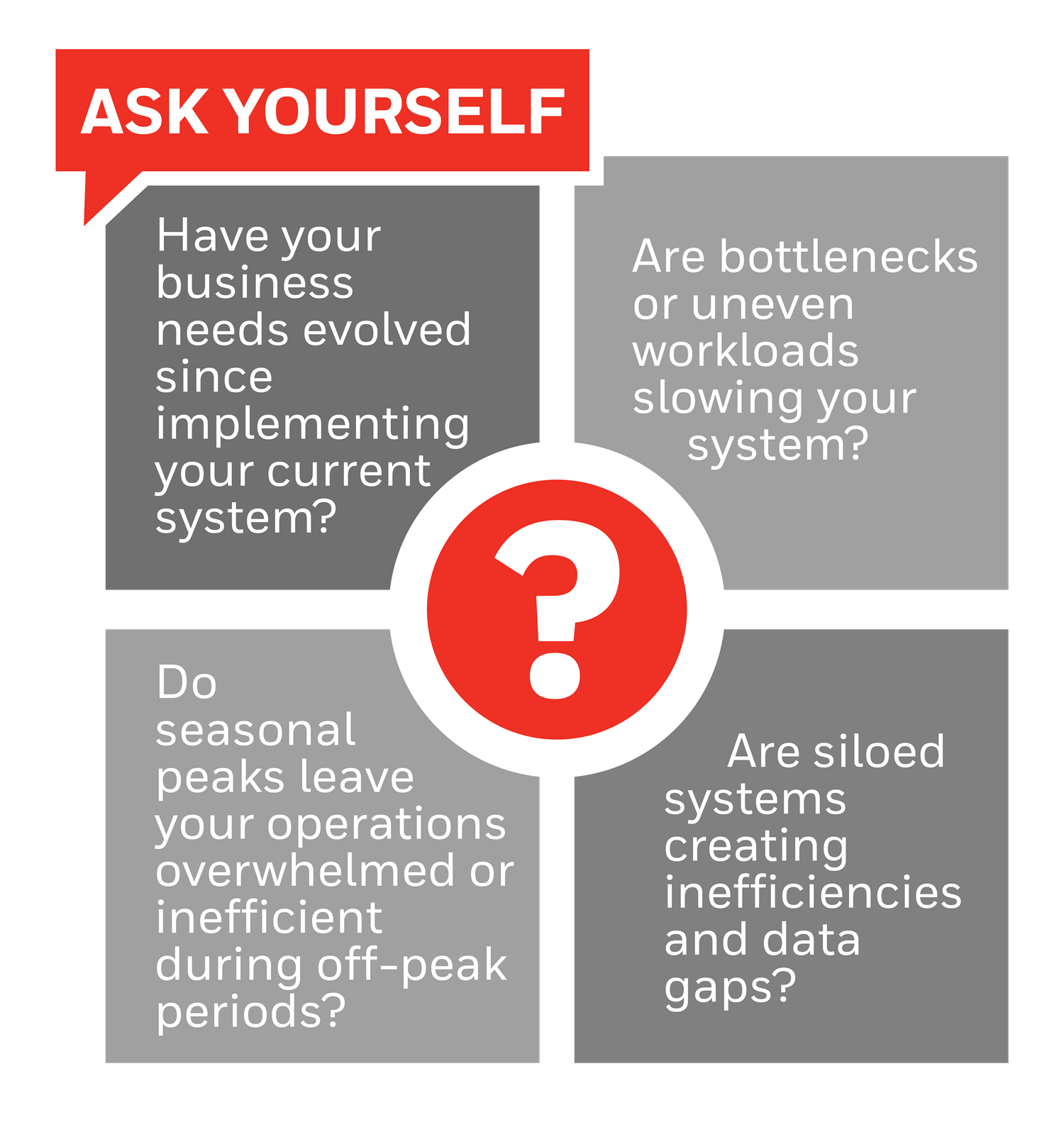In today's fast-paced logistics landscape, identifying and resolving warehouse automation bottlenecks can mean the difference between thriving and merely surviving. As distribution centers face mounting pressure from e-commerce growth, labor shortages, and customer expectations for faster deliveries, the need for smarter, more efficient warehouse operations has never been more critical.1
Automation decisions are pivotal for your business, and understanding the key considerations can make all the difference. The global supply chain has been put under pressure due to rising demand for faster delivery times, the rapid growth of e-commerce, and ongoing labor shortages. These factors have forced warehouses to re-evaluate their operations, seeking ways to increase efficiency, reduce operational bottlenecks, and maintain competitiveness in an evolving market.2
One of the biggest challenges facing warehouses today is the age and limitations of their existing sortation systems. Many of these systems are reaching the end of their lifecycle, struggling to keep pace with the rising volume of orders and increasingly complex fulfillment processes. Warehouse operators are faced with difficult choices, either make significant investments in new infrastructure or risk falling behind. Compounding this challenge is the scarcity of labor, which has only worsened in the post-pandemic era, making it even harder to scale operations to meet rising demand.3
To help you navigate these challenges, we've identified four essential questions every warehouse and distribution center operator should ask themselves to uncover hidden inefficiencies and explore how modern automation solutions can transform operations.

1. Have Your Business Needs Evolved Since Implementing Your Current System?
The Challenge
Many distribution centers operate with legacy sortation equipment designed for a different era of commerce. These aging systems—often 20-30 years old—were built before the e-commerce revolution transformed consumer expectations and order profiles. What once efficiently handled bulk shipments to retail locations now struggles with:
- Increased order volume and SKU proliferation
- Smaller, more frequent orders with varied profiles
- Demands for same-day or next-day delivery
- Seasonal fluctuations requiring greater flexibility4
In many facilities, these legacy systems have become operational bottlenecks, limiting throughput and preventing businesses from meeting current demands—let alone positioning for future growth.
The Solution
Honeywell Intelligrated's approach focuses on leveraging robotic automation to transform facilities through strategic integration of technologies like:
- Goods-to-Person Systems: Advanced solutions from partners like HAI Robotics utilize autonomous case handling robots (ACR) to bring inventory directly to operators, dramatically increasing picking efficiency while optimizing storage density.5
- Robotic Picking and Sortation: Collaborative solutions from Berkshire Grey and Tompkins Robotics enhance order fulfillment processes without requiring complete facility redesigns, providing modular scalability that adapts to changing needs.6
- Momentum Warehouse Execution System (WES): This cloud-native sophisticated software serves as the "brain" of your distribution center, orchestrating workflows across both robotic and conventional systems while optimizing order fulfillment strategies.7
Honeywell Intelligrated's brownfield approach allows businesses to maintain operations during the modernization process, integrating new technologies with existing infrastructure to extend useful life while improving throughput and efficiency.8
2. Are Bottlenecks or Uneven Workloads Slowing Down Your System?
The Challenge
Operational bottlenecks and uneven workloads remain persistent challenges for logistics, warehousing, and retail companies, particularly during demand surges and off-peak transitions. Process mining techniques enable companies to map workflows using event log data, identifying delays and resource constraints. These inefficiencies manifest in several ways:
- Process delays: When cycle times for specific workflows suddenly increase, indicating a bottleneck
- Resource constraints: Zones operating at high capacity while others remain underutilized
- Labor productivity imbalances: Some areas experiencing idle time while others struggle to keep pace
- Inventory staging congestion: Large orders creating workflow interruptions in multiple process areas.
Traditional approaches to solving these problems often involve adding labor—an increasingly difficult and expensive proposition in today's environment—or making assumptions about solutions without properly identifying root causes.
The Solution
Honeywell's approach to bottleneck resolution begins with data-driven analysis and intelligent orchestration:
- Process Analysis: The Honeywell Momentum Warehouse Execution System (WES) uses advanced algorithms to map workflows and identify constraints in real-time, providing visibility into hidden inefficiencies across your operation.9
- Dynamic Workflow Orchestration: Rather than viewing warehouse processes as separate silos, Momentum WES coordinates activities across all systems—from receiving to shipping—ensuring balanced workflows and optimized resource utilization.10
- Intelligent Labor Management: By understanding labor needs across zones, the system can proactively recommend redeployment of resources to prevent bottlenecks before they impact throughput.
Momentum WES helps establish a unified view of operations and provides real-time insights that enable proactive decision-making. The system continuously monitors KPIs and can automatically adjust workflows to prevent bottlenecks from forming, ensuring smooth operations even during periods of peak demand.
3. Do Seasonal Peaks Leave Your Operations Overwhelmed or Inefficient During Off-Peak Periods?
The Challenge
The cyclical nature of consumer demand creates major operational challenges for warehouse operators. During seasonal peaks—holidays, promotional events, or industry-specific busy seasons—operations face:
- Significantly increased order volumes
- Pressure to maintain service levels despite surge demand
- Difficulty hiring and training temporary workers
- Capacity constraints across all systems11
According to industry research, Black Friday and Cyber Monday can drive a 30-50% increase in e-commerce orders, while summer months see heightened demand for tourism-related goods and services. These peaks strain logistics networks, warehouse throughput, and staffing, often exposing vulnerabilities in inventory management and delivery systems.
Conversely, during off-peak periods, facilities often struggle with:
- Underutilized assets and excess capacity
- Fixed costs for automation that isn't fully leveraged
- Difficulty justifying automation investments given variable utilization
- Missed opportunities for maintenance and optimization12
This feast-or-famine cycle creates significant strain on operations and complicates ROI calculations for automation investments.
The Solution
Honeywell Intelligrated's approach to seasonal variability leverages robotics and flexible automation strategies:
- Robotic Automation: Solutions that scale more easily than traditional conveyor and sortation systems, providing flexibility to handle peak volumes without overbuilding for average demand.13
- Modular Automation Architectures: Flexible designs allow portions of the automation solution to be temporarily reconfigured or repurposed during off-peak periods, maintaining efficiency at various throughput levels.14
- Hybrid Human-Robot Workflows: Momentum WES coordinates workflows that optimally balance human and robotic resources based on current demand, allowing labor to focus on value-added tasks while automation handles repetitive processes.
- Predictive Analytics for Seasonal Planning: Advanced data analytics help anticipate demand patterns and proactively adjust automation strategies before peaks arrive.
Research indicates that while temporary staffing surges are common during peaks, 76% of supply chain and logistics leaders are experiencing notable workforce shortages in their operations, which has led 54% of companies in that industry to focus on automating repetitive tasks and non-value-added services.15 Solutions like robotic systems can be deployed strategically to manage these fluctuations without the challenges of recruiting, training, and managing seasonal workers.
4. Are Siloed Systems Creating Inefficiencies and Data Gaps?
The Challenge
Many warehouses have implemented point solutions over time, creating disconnected islands of automation. These siloed systems present numerous challenges:
- Lack of coordination between processes leads to sub-optimization
- Multiple control systems with different interfaces increase complexity
- Disconnected data makes end-to-end visibility impossible
- Difficulty implementing improvements that span multiple systems
- Increased maintenance requirements and technical complexity16
These silos limit the potential of individual automation components and prevent facilities from achieving true operational excellence.
The Solution
Honeywell's Momentum WES serves as the central nervous system that connects and orchestrates all elements of warehouse automation:
- Unified Control Platform: Rather than managing multiple systems separately, Momentum WES provides a single interface for controlling and optimizing all automation components.
- End-to-End Visibility: Comprehensive data collection across all systems eliminates blind spots and enables true process optimization.
- Intelligent Orchestration: Dynamic decision-making capabilities ensure resources are allocated efficiently across all warehouse functions.
- Predictive Maintenance: Centralized monitoring of all equipment enables proactive maintenance scheduling to prevent costly downtime.
- Future-Ready Flexibility: An architecture that allows new technologies to be integrated seamlessly as operations evolve.
Momentum WES creates a unified control layer that allows these previously siloed systems to work in concert, maximizing throughput and minimizing downtime.17
Putting It All Together: The Honeywell Intelligrated Approach
Addressing these four critical questions isn't just about identifying problems—it's about implementing comprehensive solutions that transform warehouse operations. Honeywell can help you solve key challenges including the replacement of aging sortation systems, increasing throughput capacity per square foot, and integrating with Honeywell's hardware and software to ensure proper orchestration, flow and rapid implementation that meets the ROI window.
We accomplish this by leveraging Honeywell Intelligrated solutions together with partner robotics systems from HAI Robotics, Berkshire Grey and Tompkins Robotics using Momentum WES that orchestrates all the elements of an automated warehouse to decrease downtime and increase system throughput. The comprehensive approach improves system efficiency, enhances reliability, and augments your existing workforce by integrating a unique combination of material handling equipment automation solutions and orchestrating the flow of work in a secure environment.
Our approach combines:
- Strategic Consulting and Analysis: Understanding your unique challenges and identifying the most impactful opportunities for improvement
- Integrated Technology Solutions: Combining robotics, software, and conventional automation in an optimized architecture tailored to your needs
- Intelligent Orchestration: Using Momentum WES to coordinate all systems and ensure smooth operations across your entire facility
- Implementation Excellence: Minimizing disruption during deployment and ensuring your team is prepared to maximize the value of your investment
- Ongoing Support and Optimization: Continuous improvement through data analysis, preventive maintenance, and system refinements.
The Future is Now
Today's warehouse leaders can't afford to wait for bottlenecks to become breaking points. The challenges of aging infrastructure, operational inefficiencies, seasonal fluctuations, and disconnected systems require immediate attention—and Honeywell Intelligrated has the expertise and solutions to address them.
By focusing on the four critical questions we've explored, you can identify your most pressing challenges and implement strategic solutions that not only solve today's problems but position your operation for long-term success in an increasingly demanding marketplace.
Ready to transform your warehouse operations and eliminate the bottlenecks holding you back? Explore these considerations and more with our team of experts – get in touch to learn more about our innovative approaches to warehouse automation that can revolutionize your operations and drive sustainable competitive advantage.
To subscribe to the Honeywell Intelligrated blog and receive exclusive communications and updates, click here.
1 Honeywell Intelligrated, Robotic Automation: Transforming Facilities, 2024 [Accessed March 3, 2025]
2 Honeywell Intelligrated, 5 Ways to Squeeze More Efficiency, 2024 [Accessed March 3, 2025]
3 Material Handling 24/7, Honeywell to Drive DC Efficiency and Enhanced Storage Capacity via Collaboration with HAI Robotics, 2024 [Accessed March 3, 2025]
4 Honeywell Intelligrated, How Warehouse Execution Systems Support Brownfield Facilities, 2024 [Accessed March 3, 2025]
5 HAI Robotics, Preparing for Peak Seasons, 2024 [Accessed March 3, 2025]
6 Honeywell Intelligrated, Robotic Automation: Transforming Facilities, 2024 [Accessed March 3, 2025]
7 Honeywell Intelligrated, Momentum WES: Brain of Your Distribution Center, 2024 [Accessed March 3, 2025]
8 Honeywell Intelligrated, How Warehouse Execution Systems Support Brownfield Facilities, 2024 [Accessed March 3, 2025]
9 Honeywell Intelligrated, Banish Automation Silos with WES, November 14, 2019 [Accessed March 3, 2025]
10 Honeywell Intelligrated, Momentum WES: Key Benefits, 2024 [Accessed March 3, 2025]
11 Entrepreneur, How to Master Peak Season Sales and Demand, 2024 [Accessed March 3, 2025]
12 Savino Del Bene, Peak Season: What It Is, When It Occurs, Consequences & How to Manage It, 2024 [Accessed March 3, 2025]
13 Honeywell Intelligrated, Robotic Automation: Transforming Facilities, 2024 [Accessed March 3, 2025]
14 Exotec, 5 Strategies for Controlling Seasonal Peaks in Warehouses, 2024 [Accessed March 3, 2025]
15 Supply Chain Brain, Automation's Role in Alleviating Labor Shortage Pressures, Chris Jones, July 12, 2024 [Accessed March 7, 2025]
16 Honeywell Intelligrated, Banish Automation Silos with WES, November 14, 2019 [Accessed March 3, 2025]
17 Honeywell Intelligrated, Momentum WES: Brain of Your Distribution Center, 2024 [Accessed March 3, 2025]






